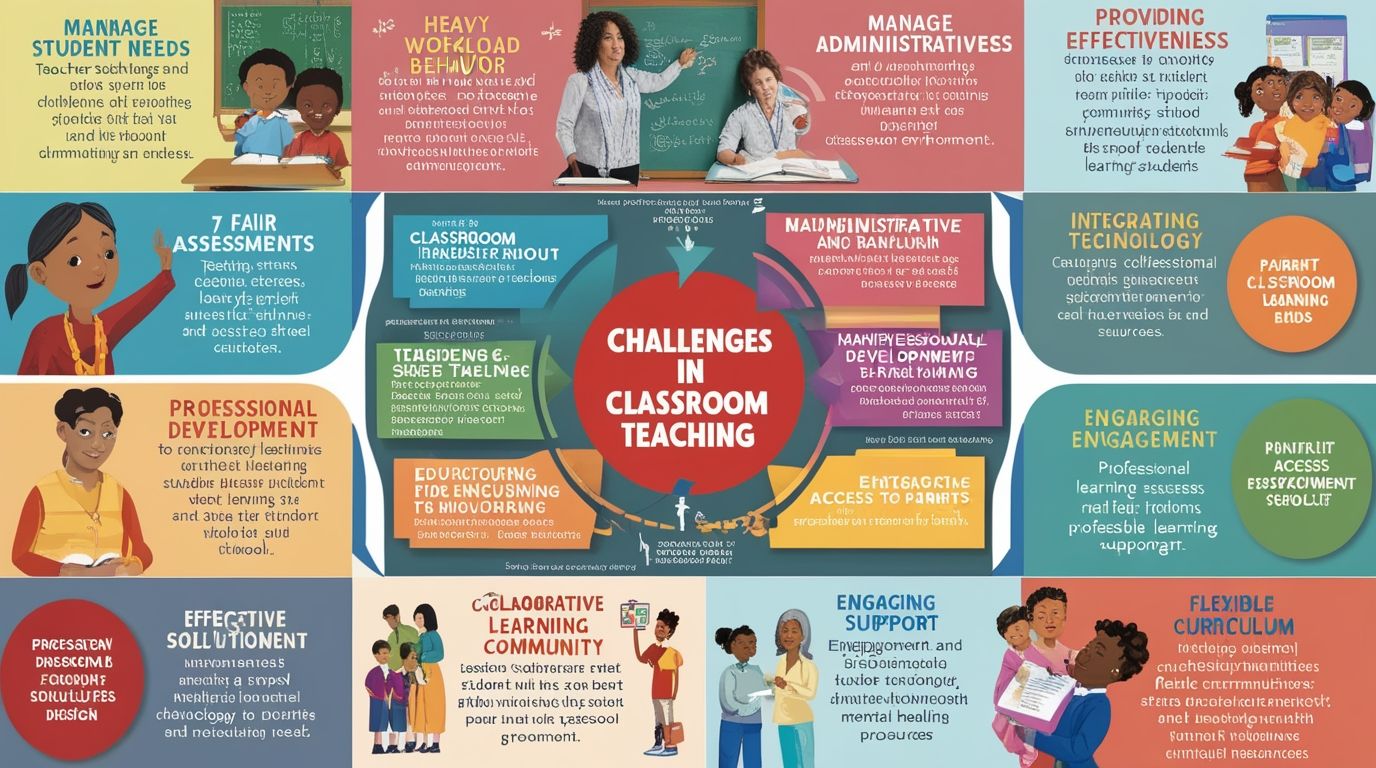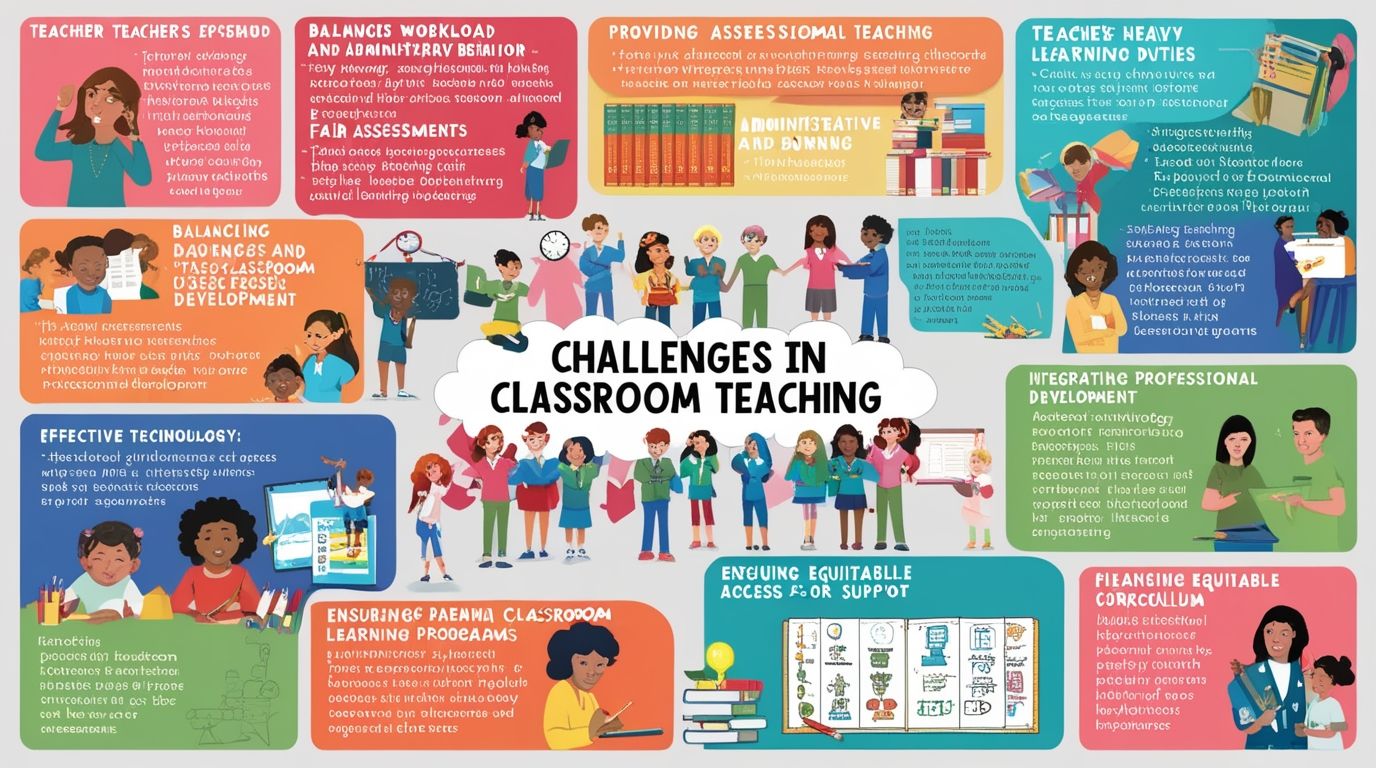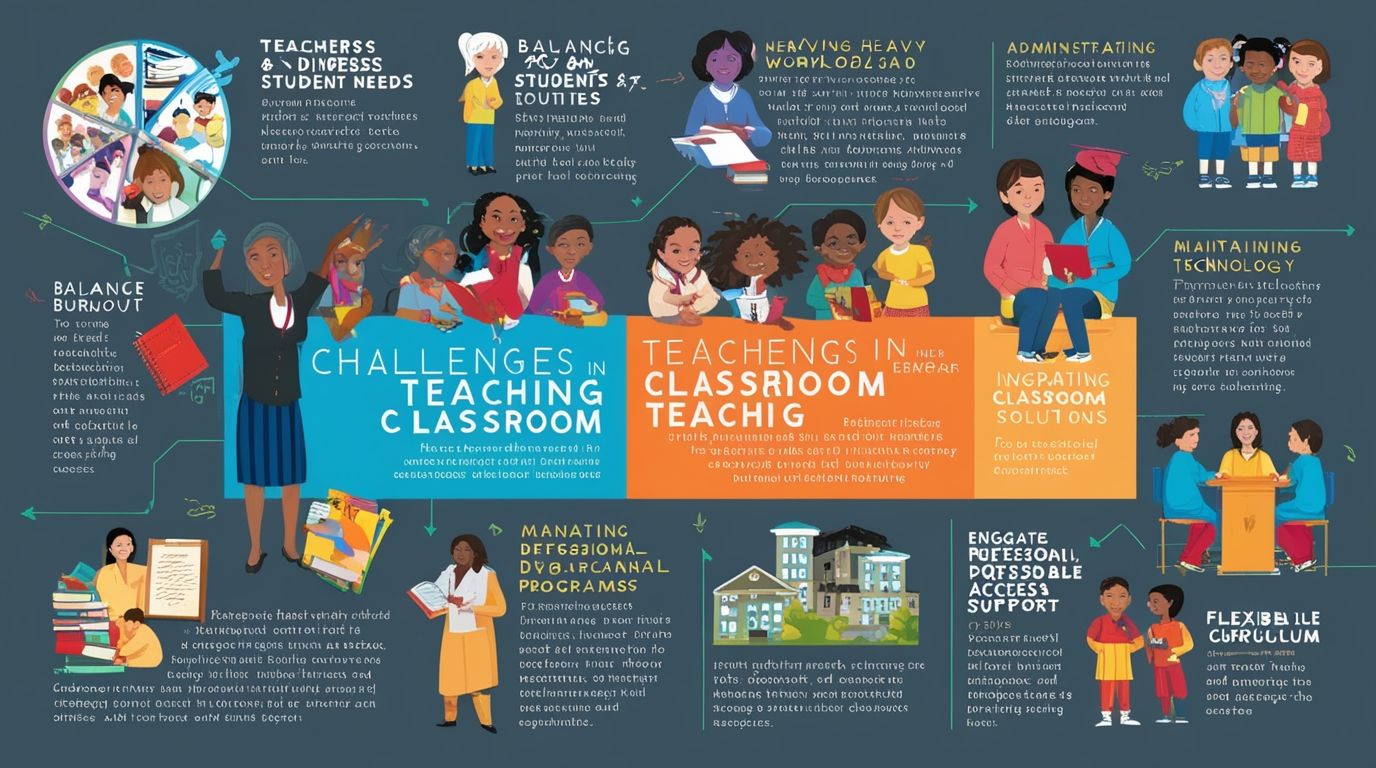Introduction
Challenges in Classroom teaching is a dynamic and demanding profession that requires educators to balance various responsibilities while addressing the diverse needs of students. Despite the rewards of shaping young minds, teachers face numerous challenges that can impact their effectiveness and well-being. This article explores the key challenges in classroom teaching and offers insights into potential solutions.
1. Diverse Student Needs
Challenges in Classroom Teaching one of the most significant challenges in classroom teaching is addressing the diverse needs of students. Every classroom comprises students with varying backgrounds, abilities, learning styles, and socio-emotional needs.
- Differentiated Instruction: Teachers must tailor their instruction to meet the needs of all learners, including those with disabilities, gifted students, and English language learners. This requires a deep understanding of each student’s strengths and weaknesses, as well as the ability to design and implement individualized learning plans.
- Socio-Emotional Needs: Students’ emotional and social well-being can significantly affect their learning. Teachers must be adept at recognizing and addressing issues such as anxiety, depression, and behavioral problems while fostering a supportive and inclusive classroom environment.

2. Classroom Management
Effective classroom management is crucial for creating a conducive learning environment. However, maintaining discipline and order can be challenging, especially with larger class sizes and diverse student behaviors.
- Behavioral Issues: Disruptive behaviors, such as talking out of turn, defiance, and inattentiveness, can hinder the learning process. Teachers need strategies to manage these behaviors while maintaining a positive and respectful classroom atmosphere.
- Consistency and Fairness: Implementing consistent and fair disciplinary measures is essential for maintaining credibility and trust with students. Teachers must balance firmness with empathy to ensure that all students feel valued and understood.
3. Assessment and Grading
Assessing student learning and providing meaningful feedback is a critical aspect of teaching, but it comes with its own set of challenges.
- Standardized Testing: The emphasis on standardized testing can pressure teachers to “teach to the test,” potentially limiting the breadth and depth of instruction. Additionally, these tests may not accurately reflect all students’ abilities and progress.
- Subjective Grading: Grading can be subjective, and ensuring fairness and consistency can be challenging, especially with subjective assignments like essays and projects. Teachers need clear rubrics and guidelines to minimize bias and provide constructive feedback.

4. Workload and Time Management
The workload for teachers can be overwhelming, with responsibilities extending beyond classroom instruction to include lesson planning, grading, professional development, and extracurricular activities.
- Time Constraints: Teachers often struggle to find sufficient time to plan engaging lessons, assess student work, and provide individualized support. Balancing these tasks with personal life can lead to burnout.
- Administrative Duties: In addition to teaching, educators are required to handle administrative tasks, such as maintaining student records, communicating with parents, and attending meetings. These duties can detract from the time and energy available for instructional planning and student interaction.
5. Technology Integration
While technology can enhance learning, integrating it effectively into the classroom poses challenges.
- Access and Equity: Not all students have equal access to technology, creating a digital divide. Teachers must ensure that all students can benefit from technological tools and resources.
- Professional Development: Keeping up with rapidly evolving educational technology requires ongoing professional development. Teachers need training and support to effectively incorporate technology into their teaching practices.
6. Professional Development
Continuous professional development is essential for teachers to stay current with educational trends and improve their practice. However, finding time and resources for meaningful professional growth can be challenging.
- Availability and Relevance: Access to high-quality professional development opportunities that are relevant to specific teaching contexts can be limited. Teachers need professional development that is practical, evidence-based, and tailored to their needs.
- Implementation: Applying new strategies and knowledge gained from professional development can be challenging without adequate support and resources. Teachers need time to experiment with new approaches and receive feedback.
7. Parental Involvement
Engaging parents and guardians in their children’s education is crucial for student success, but it can be challenging to foster effective communication and collaboration.
- Communication Barriers: Language barriers, cultural differences, and varying levels of parental education can hinder effective communication. Teachers need strategies to bridge these gaps and build strong partnerships with families.
- Parental Support: Not all parents are able or willing to support their children’s education consistently. Teachers may need to provide guidance on how parents can assist with homework, study habits, and behavior management at home.
8. Emotional and Mental Well-being
Teaching is a demanding profession that can take a toll on educators’ emotional and mental well-being.
- Stress and Burnout: The pressures of meeting academic standards, managing classroom behavior, and balancing workload can lead to stress and burnout. Teachers need access to mental health resources and supportive networks.
- Work-Life Balance: Maintaining a healthy work-life balance is crucial for preventing burnout and ensuring long-term effectiveness. Teachers need strategies to manage their time and prioritize self-care.

Potential Solutions and Strategies
- Professional Development and Support: Schools should provide ongoing professional development that is practical and relevant. Mentoring programs and collaborative planning time can support teachers in implementing new strategies.
- Collaborative Learning Communities: Creating communities of practice where teachers can share resources, strategies, and support can enhance professional growth and reduce isolation.
- Parental Engagement Programs: Schools can develop programs to engage parents, such as workshops, newsletters, and parent-teacher conferences. Providing resources in multiple languages and offering flexible meeting times can improve communication.
- Technology Integration Training: Providing teachers with training and support for integrating technology can enhance their confidence and effectiveness. Ensuring equitable access to technology for all students is also crucial.
- Mental Health Resources: Schools should prioritize the well-being of teachers by providing access to mental health resources, counseling, and wellness programs. Encouraging a healthy work-life balance can prevent burnout.
- Flexible Curriculum Design: Adopting flexible curricula that allow for differentiated instruction and personalized learning can help meet the diverse needs of students. Project-based learning and inquiry-based approaches can enhance engagement.
- Effective Classroom Management Training: Professional development focused on classroom management strategies can help teachers maintain a positive learning environment. Techniques such as positive reinforcement, clear expectations, and restorative practices can be effective.
Conclusion
Classroom teaching is a challenging yet rewarding profession that requires educators to navigate a complex array of responsibilities and obstacles. By acknowledging and addressing these challenges through professional development, support systems, and innovative strategies, schools can empower teachers to create effective and inclusive learning environments. Ultimately, supporting teachers in overcoming these challenges is essential for fostering student success and ensuring the long-term sustainability of the teaching profession.

F*ckin’ remarkable things here. I’m very glad to see your post. Thanks a lot and i am looking forward to contact you. Will you kindly drop me a e-mail?
I was able to find good advice from your blog articles.
Also visit my web-site; nordvpn coupons inspiresensation (https://t.co/3I68DHXKpG)
You have mentioned very interesting details! ps decent internet site.
I must express my thanks to this writer for rescuing me from such a challenge. As a result of surfing throughout the online world and seeing suggestions which were not powerful, I figured my life was done. Living minus the approaches to the issues you’ve resolved all through your blog post is a crucial case, and the ones which could have in a negative way affected my career if I hadn’t discovered your site. Your personal skills and kindness in taking care of a lot of things was helpful. I don’t know what I would’ve done if I hadn’t come upon such a subject like this. I can also now relish my future. Thanks a lot so much for your high quality and sensible guide. I will not be reluctant to refer the sites to anybody who should receive guide on this subject.
Hello this is somewhat of off topic but I was wanting to know if blogs use WYSIWYG editors or if you have to manually code with HTML. I’m starting a blog soon but have no coding knowledge so I wanted to get guidance from someone with experience. Any help would be greatly appreciated!
Whats Going down i’m new to this, I stumbled upon this I have discovered It positively helpful and it has aided me out loads. I am hoping to contribute & assist different users like its helped me. Good job.
There is noticeably a bundle to know about this. I assume you made certain nice points in features also.
Very great information can be found on web site.
I’m not that much of a internet reader to be honest but your blogs really nice, keep it up! I’ll go ahead and bookmark your site to come back later on. All the best
I am curious to find out what blog system you’re working with? I’m having some minor security problems with my latest blog and I’d like to find something more secure. Do you have any suggestions?
Istanbul Old City tour Istanbul is now on my list to visit again. https://tiesawards.com/istanbul-city-tours.html
This post cleared up so many questions for me.
This made me rethink some of my assumptions. Really valuable post.
It’s great to see someone explain this so clearly.
This was so insightful. I took notes while reading!
This was really well done. I can tell a lot of thought went into making it clear and user-friendly. Keep up the good work!
I appreciate the honesty and openness in your writing.
This was a very informative post. I appreciate the time you took to write it.
Such a thoughtful and well-researched piece. Thank you.
This was a great reminder for me. Thanks for posting.
Thank you for covering this so thoroughly. It helped me a lot.
Thank you for making this topic less intimidating.
Thank you for making this topic less intimidating.
I’ve gained a much better understanding thanks to this post.
Your passion for the topic really shines through.
I love how well-organized and detailed this post is.
Usually I do not read article on blogs however I would like to say that this writeup very compelled me to take a look at and do it Your writing style has been amazed me Thank you very nice article
What i do not realize is in fact how you are no longer actually much more wellfavored than you might be right now Youre very intelligent You recognize thus considerably in relation to this topic made me in my view believe it from numerous numerous angles Its like men and women are not fascinated until it is one thing to do with Lady gaga Your own stuffs excellent All the time handle it up
I enjoyed every paragraph. Thank you for this.
You have a real gift for explaining things.
Your writing is like a breath of fresh air in the often stale world of online content. Your unique perspective and engaging style set you apart from the crowd. Thank you for sharing your talents with us.
I just could not depart your web site prior to suggesting that I really loved the usual info an individual supply in your visitors Is gonna be back regularly to check up on new posts
This was really well done. I can tell a lot of thought went into making it clear and user-friendly. Keep up the good work!
I really needed this today. Thank you for writing it.
What a helpful and well-structured post. Thanks a lot!
I’ll definitely come back and read more of your content.
Your breakdown of the topic is so well thought out.
I appreciate your unique perspective on this.
I learned something new today. Appreciate your work!
I appreciate your unique perspective on this.
This gave me a lot to think about. Thanks for sharing.
This is one of the best explanations I’ve read on this topic.
Your advice is exactly what I needed right now.
Thank you for covering this so thoroughly. It helped me a lot.
Your advice is exactly what I needed right now.
I love the clarity in your writing.
It’s great to see someone explain this so clearly.
Thank you for making this topic less intimidating.
Your breakdown of the topic is so well thought out.
Your writing style makes complex ideas so easy to digest.
You always deliver high-quality information. Thanks again!
You’ve clearly done your research, and it shows.
Simply a smiling visitant here to share the love (:, btw outstanding style and design.
You should take part in a contest for one of the best blogs on the web. I will recommend this site!
This answered all my questions. Watch Live Tv online in HD. Stream breaking news, sports, and top shows anytime, anywhere with fast and reliable live streaming.
I love the efforts you have put in this, thanks for all the great content.